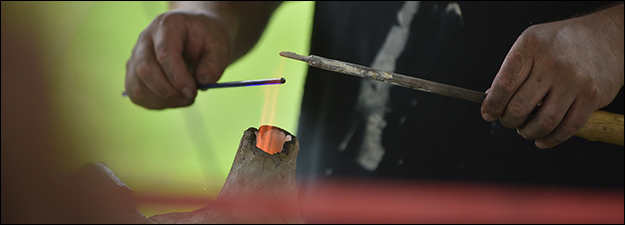Mission and Crusade in the Life and Works of Ramon Llull (1232-1316): Papers in Honor of the Seven-Hundredth Anniversary of His Death
Sponsoring Organization(s)
Special Session
Organizer Name
Michael J. Sanders
Organizer Affiliation
Fordham Univ.
Presider Name
Larry J. Simon
Presider Affiliation
Western Michigan Univ.
Paper Title 1
Finding Common Ground: Llull's Use of the Ten Commandments in the Disputatio Raymundi Christiani et Hamar Saraceni
Presenter 1 Name
Patrick Harris
Presenter 1 Affiliation
Western Michigan Univ.
Paper Title 2
The Dilemma of Force and Persuasion in Llull's Llibre contra Anticrist/Liber contra Antichristum
Presenter 2 Name
Pamela Beattie
Presenter 2 Affiliation
Univ. of Louisville
Paper Title 3
Respondent
Presenter 3 Name
Amy M. Austin
Presenter 3 Affiliation
Univ. of Texas-Arlington
Paper Title 4
Respondent
Presenter 4 Name
Mark D. Johnston
Presenter 4 Affiliation
DePaul Univ.
Start Date
13-5-2016 3:30 PM
Session Location
Schneider 1245
Description
2016 marks the 700th anniversary of the death of Ramon Llull (1232-1316), a mystic, missionary, and philosopher from the Crown of Aragon. Llull wrote an impressive corpus of 265 works, including a novel, collections of poems, and numerous treatises, dedicated to spreading Latin Christianity throughout the world. Though initially a lusty troubadour, Llull experienced mystic visions of Christ on the Cross in his thirties, and devoted the rest of his life to bringing all peoples, especially Muslims and Jews, into the Catholic Church.
Llull believed that he could convert the world through a variety of proselytization methods. Many of his works propose the establishment of schools that train missionaries in foreign languages and in his own Neoplatonic philosophy known as the Art. Llull envisioned these missionaries traveling to far-off lands and convincing non-Christians to convert through intellectual disputations. Llull, in fact, taught himself Arabic and participated in intellectual disputations on three missions to North Africa. He also urged popes and princes to launch crusades, especially after the loss of Acre in 1291, to regain lost Christian lands and aid missionary efforts.
In this session, further light will be shed on the methods of Llull's conversion program. Patick Harris will focus on the Neoplatonic elements of the Lullian Art found in the Disputatio Raymundi Christiani et Hamar Saraceni. Llull thought his Art could convince non-Christians to convert because these Neoplatonic elements, not to mention many spiritual ideas like the Ten Commandments, were common to Christian, Jewish, and Islamic traditions. Pamela Beattie will explain the relationship between Llull’s missionary and crusade plans by examining the most famous Lullian work on apocalypticism, the Llibre contra Anticrist. Originally written in Catalan and then translated into Latin nearly twenty years later, this work reveals the eschatological, political, and religious ideas that underpinned the Lullian conversion program throughout its author’s life. It also provides evidence of the influence that the Spiritual Franciscans had on Llull. Amy M. Austin and Mark D. Johnston, editors of an upcoming volume on Llull's life and legacy, will respond to these papers and offer their own comments on Llull's conversion program.
Mission and Crusade in the Life and Works of Ramon Llull (1232-1316): Papers in Honor of the Seven-Hundredth Anniversary of His Death
Schneider 1245
2016 marks the 700th anniversary of the death of Ramon Llull (1232-1316), a mystic, missionary, and philosopher from the Crown of Aragon. Llull wrote an impressive corpus of 265 works, including a novel, collections of poems, and numerous treatises, dedicated to spreading Latin Christianity throughout the world. Though initially a lusty troubadour, Llull experienced mystic visions of Christ on the Cross in his thirties, and devoted the rest of his life to bringing all peoples, especially Muslims and Jews, into the Catholic Church.
Llull believed that he could convert the world through a variety of proselytization methods. Many of his works propose the establishment of schools that train missionaries in foreign languages and in his own Neoplatonic philosophy known as the Art. Llull envisioned these missionaries traveling to far-off lands and convincing non-Christians to convert through intellectual disputations. Llull, in fact, taught himself Arabic and participated in intellectual disputations on three missions to North Africa. He also urged popes and princes to launch crusades, especially after the loss of Acre in 1291, to regain lost Christian lands and aid missionary efforts.
In this session, further light will be shed on the methods of Llull's conversion program. Patick Harris will focus on the Neoplatonic elements of the Lullian Art found in the Disputatio Raymundi Christiani et Hamar Saraceni. Llull thought his Art could convince non-Christians to convert because these Neoplatonic elements, not to mention many spiritual ideas like the Ten Commandments, were common to Christian, Jewish, and Islamic traditions. Pamela Beattie will explain the relationship between Llull’s missionary and crusade plans by examining the most famous Lullian work on apocalypticism, the Llibre contra Anticrist. Originally written in Catalan and then translated into Latin nearly twenty years later, this work reveals the eschatological, political, and religious ideas that underpinned the Lullian conversion program throughout its author’s life. It also provides evidence of the influence that the Spiritual Franciscans had on Llull. Amy M. Austin and Mark D. Johnston, editors of an upcoming volume on Llull's life and legacy, will respond to these papers and offer their own comments on Llull's conversion program.

